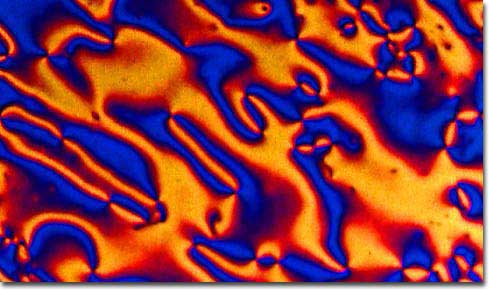In Synch

Cigar-shaped liquid crystal molecules move randomly but can all point in the same direction, leading to pretty colors. Electrons restricted to a plane can form pockets of density "stripes" which show similar behavior. A new theory offers some potentially testable predictions for this idea. Image credit: M. W. Davidson, Florida State University, Fermilab.
Electrons don't normally know one direction from another, so researchers were perplexed a few years ago when they found a cold plane of electrons suddenly choosing to conduct many times better in one direction than in the perpendicular one. Maybe they could acquire a preferred orientation by acting like liquid crystals, theorists proposed. A group of physicists has recently reported that it has worked this theory out well enough that experimenters may finally have some detailed signs to search for.
The puzzling result appeared when electrons were sandwiched between very smooth gallium arsenide semiconductor crystals and put under a magnetic field perpendicular to the plane--the famous quantum Hall state. When researchers chilled them and applied the right field strength, the electrons consistently chose one direction (with respect to the crystal axes) in which to dramatically maximize their conductivity. The effect seemed similar to the alignment of domains in magnetic materials under an applied field or the electrically induced ordering of cigar-shaped liquid crystal molecules. But in these other examples, the particles have a preferred direction built in.
One way for electrons to pick out a direction is to line up in "charge density waves"--alternating rows of high and low electron density. Such striped states show up in a variety of systems where a long range, repulsive force competes with a short range, attractive one. For electrons, the Pauli exclusion principle paradoxically leads to an effective attraction that balances the particles' electrostatic repulsion at short distances. Researchers believe this tension results in stripes that are stable under magnetic fields of a certain strength. Fluctuations and branches in these stripes should create a maze riddled with patches of stripes pointing in various directions, like randomly oriented liquid crystal molecules.
Read more about this research at Physical Review Focus.
Text courtesy of Physical Review Focus.











